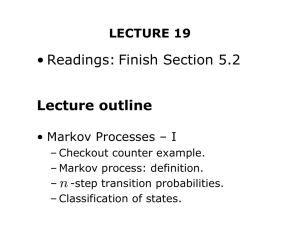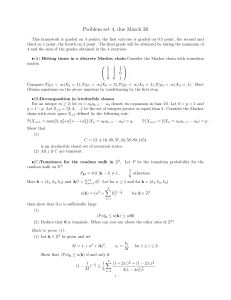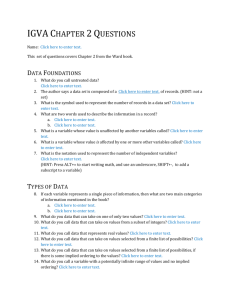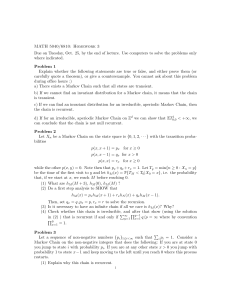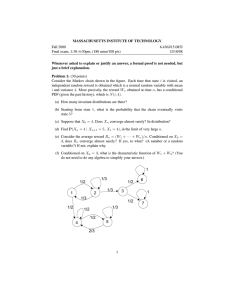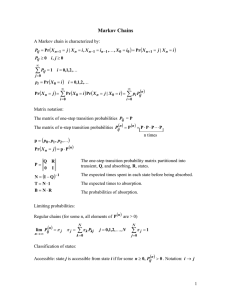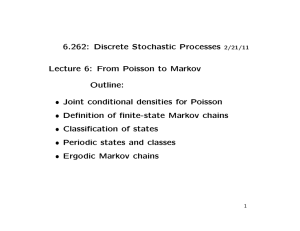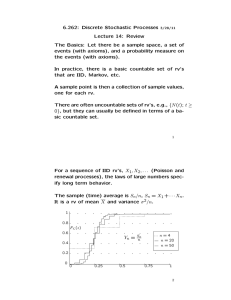Problem set 3, due March 13
advertisement
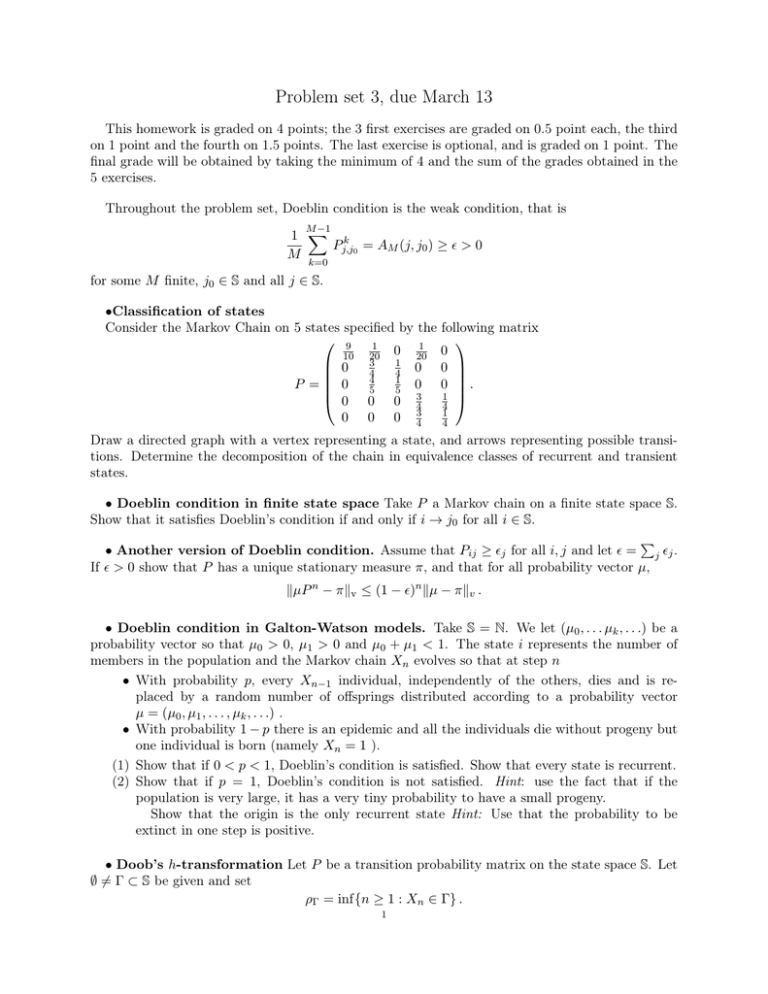
Problem set 3, due March 13
This homework is graded on 4 points; the 3 first exercises are graded on 0.5 point each, the third
on 1 point and the fourth on 1.5 points. The last exercise is optional, and is graded on 1 point. The
final grade will be obtained by taking the minimum of 4 and the sum of the grades obtained in the
5 exercises.
Throughout the problem set, Doeblin condition is the weak condition, that is
M −1
1 X k
Pj,j0 = AM (j, j0 ) ≥ > 0
M
k=0
for some M finite, j0 ∈ S and all j ∈ S.
•Classification of states
Consider the Markov Chain on 5 states specified by the following matrix
9
1
1
10
20 0
20 0
1
3
0
0
4
4 0
4
1
P = 0
0
5
5 0
.
1
0 0 0 3
4
4
1
0 0 0 34
4
Draw a directed graph with a vertex representing a state, and arrows representing possible transitions. Determine the decomposition of the chain in equivalence classes of recurrent and transient
states.
• Doeblin condition in finite state space Take P a Markov chain on a finite state space S.
Show that it satisfies Doeblin’s condition if and only if i → j0 for all i ∈ S.
P
• Another version of Doeblin condition. Assume that Pij ≥ j for all i, j and let = j j .
If > 0 show that P has a unique stationary measure π, and that for all probability vector µ,
kµP n − πkv ≤ (1 − )n kµ − πkv .
• Doeblin condition in Galton-Watson models. Take S = N. We let (µ0 , . . . µk , . . .) be a
probability vector so that µ0 > 0, µ1 > 0 and µ0 + µ1 < 1. The state i represents the number of
members in the population and the Markov chain Xn evolves so that at step n
• With probability p, every Xn−1 individual, independently of the others, dies and is replaced by a random number of offsprings distributed according to a probability vector
µ = (µ0 , µ1 , . . . , µk , . . .) .
• With probability 1 − p there is an epidemic and all the individuals die without progeny but
one individual is born (namely Xn = 1 ).
(1) Show that if 0 < p < 1, Doeblin’s condition is satisfied. Show that every state is recurrent.
(2) Show that if p = 1, Doeblin’s condition is not satisfied. Hint: use the fact that if the
population is very large, it has a very tiny probability to have a small progeny.
Show that the origin is the only recurrent state Hint: Use that the probability to be
extinct in one step is positive.
• Doob’s h-transformation Let P be a transition probability matrix on the state space S. Let
∅=
6 Γ ⊂ S be given and set
ρΓ = inf{n ≥ 1 : Xn ∈ Γ} .
1
2
Let the h-transform associated to a function h be given by
1
P̂ij =
Pij h(j)
for (i, j) ∈ S2
h(i)
(A) Take
h(i) = P(ρΓ = ∞|X0 = i)
for all i ∈ Ŝ = S\Γ ,
and assume h(i) > 0 for all i ∈ Ŝ.
P
(1) Show that h(i) = j∈Ŝ Pij h(j) for all i ∈ Ŝ and conclude that the matrix P̂ is a transition
probability matrix on Ŝ.
(2) For all n ∈ N and (j1 , . . . , jn ) ∈ (Ŝ)n , show that for each i ∈ Ŝ,
P̂(X1 = j1 , . . . , Xn = jn |X0 = i) = P(X1 = j1 , . . . , Xn = jn |ρΓ = ∞ and X0 = i)
where P̂ is the probability computed from the transition probability matrix P̂ . Hence P̂ is
the Markov chain determined by P conditioned to never hit Γ.
(B) Assume that j0 ∈ S is transient but i → j0 for all i ∈ S and take
h(i) = P (ρj0 < ∞|X0 = i)
for i 6= j0 ,
h(j0 ) = 1 .
(1) Show that h(i) > 0 and set
P̃ij = P̂ij if i 6= j0 ,
P̃j0 j = Pj0 j
Show that P̃ is a transition probability matrix.
(2) Denoting P̃ the probability computed relative to the chain determined by P̃ show that
1
P̃(ρj0 > n|X0 = i) =
P(n < ρj0 < ∞|X0 = i)
h(i)
for all n ∈ N and i 6= j0 . Hint: Expand P̃(ρj0 > n|X0 = i)h(i) in terms of the transition
probability matrix P .
(3) Using the last result show that j0 is recurrent for the chain determined by P̃ .
• Optional: Doeblin condition in card shuffling. We consider a stack of 52 different
cards and the following shuffling: at each time step, two cards are chosen uniformly randomly and
exchanged. The two cards have to be different. Let S be the set of all possible ordering of the
cards. Identifying the cards with a sequence of numbers {1, 2, . . . , 52}, an ordering is a function
f : {1, 2, . . . , 52} → {1, 2, . . . , 52} so that f (i) 6= f (j) iff i 6= j. S is the set of all these functions.
(1) Show that the above shuffling can be interpreted as a random walk on S; if Xn is the ordering
at time n for all i, j ∈ S
2
P(Xn = i|Xn−1 = j) =
51 × 52
if iand j differs exactly at two sites, otherwise the probability of transition from j to i
vanishes.
(2) Show that this Markov chain satisfies (the weak) Doeblin’s condition. Hint: Show that you
can transform a configuration i into a configuration j in less than 52 steps and deduce that
for all i, j ∈ S
1
1
A52 (i, j) ≥ (
)52
52 51 × 26
(3) Describe the stationary measure of this chain as well as the recurrence/transience of the
states.
n ≥ for all j satisfied ?
(4) Is the strong Doeblin condition Pjj
0
